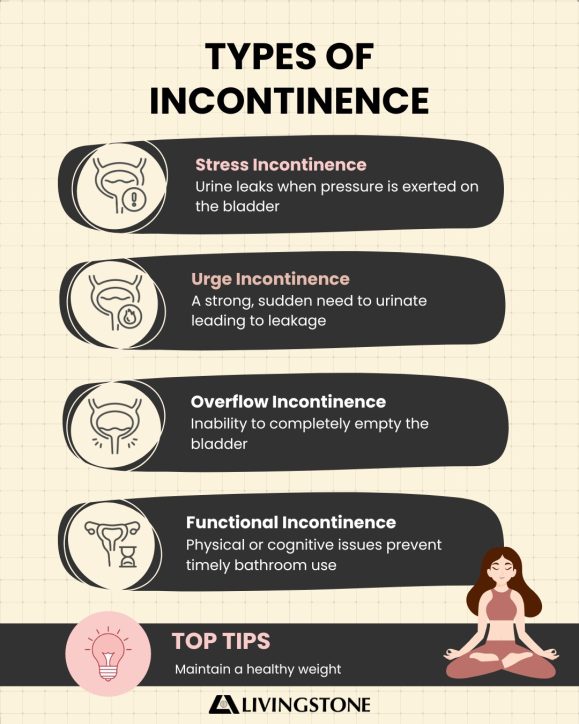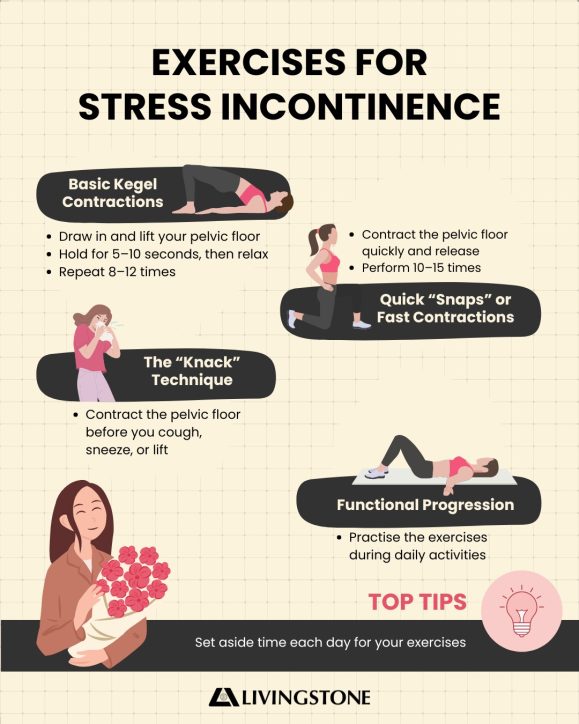Stress urinary incontinence (SUI) is one of the most common forms of bladder leakage, particularly among women, but also affects men following prostate surgery. It occurs when physical pressure on the bladder causes unintentional urine loss. Everyday actions such as coughing, laughing, lifting, or exercising can trigger leakage, often leading to embarrassment, reduced confidence, and avoidance of social or physical activities.

Understanding how stress incontinence develops, how the pelvic floor muscles play a role, and what management strategies are available is essential to improving bladder control and overall wellbeing.
Understanding Stress Incontinence
Stress incontinence results from weakness or dysfunction in the muscles and tissues that support the bladder and urethra. When the pressure inside the abdomen suddenly increases, the bladder outlet may fail to stay closed, allowing urine to escape.
This weakness can be caused by pregnancy and childbirth, hormonal changes during menopause, obesity, chronic coughing, constipation, or repetitive heavy lifting. In men, prostate surgery may also affect the sphincter and pelvic support structures. The result is the same: the body struggles to maintain urethral closure when under strain.
While not life-threatening, the condition can have a significant impact on quality of life. Individuals may limit exercise, reduce fluid intake unnecessarily, or experience emotional distress due to the unpredictability of leakage. Early intervention and professional assessment are crucial to managing symptoms effectively.
The Role of Pelvic Floor Muscles
The pelvic floor muscles form a supportive sling across the base of the pelvis, holding the bladder, bowel, and reproductive organs in place. When functioning well, they contract to support the urethra and prevent urine leakage during increases in abdominal pressure.
Weak or poorly coordinated pelvic floor muscles are a major contributor to stress incontinence. Pregnancy, childbirth, ageing, or surgery can stretch or damage these muscles, reducing their ability to respond quickly when pressure rises. Strengthening them through targeted training helps restore support to the bladder and improves control.
According to the Continence Foundation of Australia, pelvic floor muscle training is considered first-line therapy for stress urinary incontinence and has strong evidence of success when performed correctly and consistently under professional guidance.
Pelvic Floor Exercises
Pelvic floor muscle training, often referred to as “Kegel exercises”, involves contracting and relaxing the muscles that control urination. The goal is to build both strength and endurance so the muscles can react effectively during activities that cause pressure on the bladder.
To perform the exercise correctly:
- Sit or lie comfortably and focus on the muscles you would use to stop urinating.
- Gently contract and lift those muscles upward.
- Hold the contraction for 5–10 seconds, then relax for the same amount of time.
- Repeat 8–12 times in one session, aiming for three sessions per day.
As control improves, exercises can be practised while standing, walking, or before actions such as coughing or lifting. This “anticipatory” contraction, often called the knack, trains the muscles to respond automatically when needed.

A physiotherapist or continence clinician can provide a personalised program, ensure correct muscle engagement, and use biofeedback or ultrasound for assessment if necessary.
Additional Management Strategies
Strengthening the pelvic floor is the foundation of stress incontinence management, but other approaches may complement it.
- Lifestyle adjustments: Maintaining a healthy weight reduces abdominal pressure on the bladder. Managing constipation and avoiding excessive straining during bowel movements also protects pelvic floor strength.
- Bladder habits: Regular voiding schedules can prevent overfilling, but restricting fluid intake too much can irritate the bladder and worsen symptoms.
- Smoking cessation: A Chronic cough from smoking can repeatedly strain the pelvic floor.
- Physical conditioning: Core stability exercises under physiotherapy supervision can improve pelvic control and posture.
For persistent cases, medical evaluation is recommended. Urologists or continence specialists may discuss surgical or procedural options, including sling procedures or urethral bulking treatments, depending on severity and underlying cause. Further information on evidence-based treatment options is available through the Australian Commission on Safety and Quality in Health Care.
Stress incontinence is both common and treatable. With structured pelvic floor training, healthy lifestyle habits, and professional support, most individuals regain significant control and comfort. Addressing the issue early helps prevent progression and reduces the emotional impact that often accompanies bladder leakage.
For healthcare professionals and patients alike, understanding the connection between pelvic floor health and continence forms the cornerstone of effective management. Through awareness, education, and consistent care, it is possible to restore confidence and improve quality of life.
Shop trusted urinary incontinence aids designed for all levels of support and mobility.
References
Australian Commission on Safety and Quality in Health Care 2021, Treatment options for stress urinary incontinence (SUI), Australian Commission on Safety and Quality in Health Care, viewed 7 October 2025, https://www.safetyandquality.gov.au/publications-and-resources/resource-library/treatment-options-stress-urinary-incontinence-sui.
Continence Foundation of Australia 2024, Pelvic floor muscle training for women, Continence Foundation of Australia, viewed 7 October 2025, https://www.continence.org.au/.
